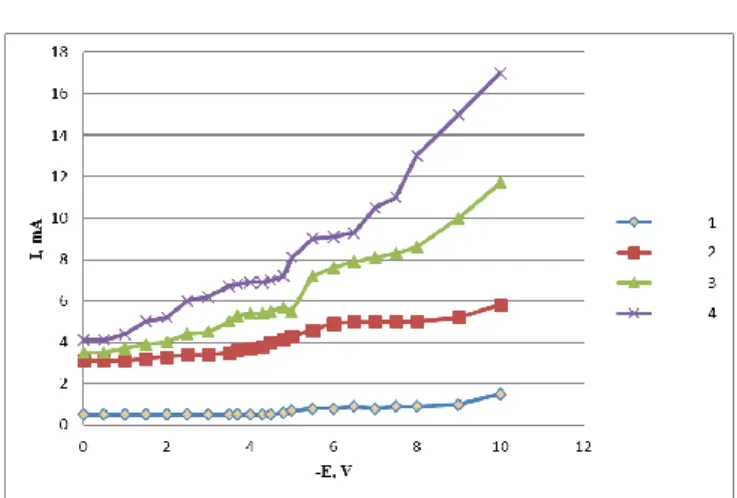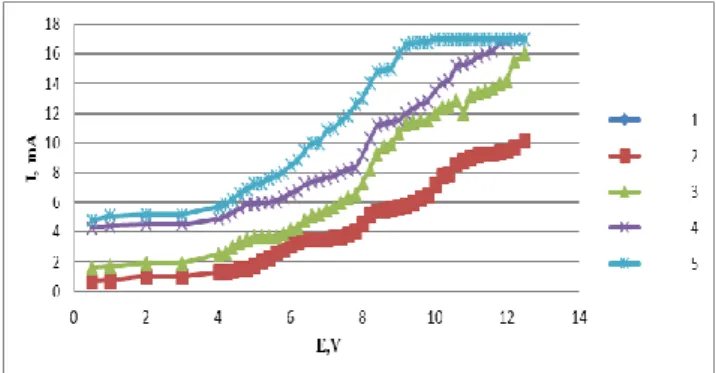Electroreduction of manganese in K,Na//Cl and K//F,Cl melts Section D-Research paper
Eur. Chem. Bull., 2018, 7(2), 59-62 DOI: 10.17628/ecb.2018.7.59-62
59
ELECTROREDUCTION OF MANGANESE(II) CHLORIDE IN KCl-NaCl AND KCl-KF MELTS
Nodari Gasviani,
[a]Gulnara Kipiani,
[a]Shalva Andguladze
[b]Marine Khutsishvili
[a]and Nino Skhiladze
[a]Keywords: electroreduction; manganese chloride; molten salts; voltammetry.
The electroreduction of manganese(II) chloride from chloride (NaCl-KCl) and fluoride-chloride (KCl-KF) melts has been studied in air atmosphere by polarography. In both melts, metallic manganese was obtained and the mechanism of the reduction of manganese(II)–ions was elucidated. Optimal parameters of the process could also be established.
* Corresponding Authors Tel: +995 (032) 2 30 14 30 E-Mail: nodargasviani@mail.ru
[a] R. Agladze Institute of Inorganic Chemistry and Electrochemistry of Ivane Javakhishvili Tbilisi State University, Georgia, Tbilisi, Mindeli str. 11, 0186
[b] Georgian Technical University, Georgia, Tbilisi, Kostava str.
77, 0175
INTRODUCTION
Electrolytic preparation of metallic manganese and manganese alloys from melts and solutions has high industrial importance. Electrochemical preparation of metallic manganese from melts economically can only be competitive with the known electrochemical method based on aqueous or ionic liquid electrolyte solutions if the target compounds are special material like high-melting metal composites or alloys.1,2
EXPERIMENTAL
For the preparation of metallic manganese anhydrous MnCl2 was used as a depolarizer. The experiments were carried out in the melts K, Na/Cl and K/Cl, F between 973 and 1023 K temperatures.
Voltammetric characteristics were taken using the potentiostat PI-50-1. Three electrode cell was used. A platinum wire was used as the cathode, glass-graphite crucible - as the anode and as the melt container. Platinum plate presented the reference electrode. The use of lead reference electrode was proved to be consistently unappropriated.
RESULTS AND DISCUSSION
The purity of KCl-NaCl was checked using voltammetry (Fig. 1). After addition of MnCl2 to the melt KCl-NaCl (briefly over 1-2 minutes) only one wave occurs on the voltammogram (Fig. 1, curve 2), but after a period two additional waves appear (Fig. 1, curves 3, 4). The height of all three waves was nearly equal, the potentials were found to be -0.6÷ - 0.7, -0.78÷-1.0 and -1.1÷-1.3 V, respectively.
Figure 1. Voltammograms of electroreduction of manganese chloride in K,Na/Cl melt: 1-background, 2-background+MnCl2 (0.2 wt.%), 3-background+MnCl2 (0.6 wt. %), 4- background+MnCl2( 0.1 wt. %). Platinum as cathode and reference electrode, T=973 K
It is well known3 that Mn(II) transforms into Mn(VI) ion melts due to oxidation with the oxygen content of the air
MnII MnIV+2e- MnIV MnVI+2e-
The three waves observed on the voltammograms shows the three-step reduction of Mn(VI) to metallic manganese according to the following scheme:
MnVI+2e- MnIV wave I MnIV+2e- MnII wave II MnII+2e- Mn wave III
The electrolysis at the potentials corresponds to limiting currents of waves I and II did not produce any precipitate because the electrolysis products formed at the cathode (intermediate compounds) could re-dissolve in the electrolyte.
Electroreduction of manganese in K,Na//Cl and K//F,Cl melts Section D-Research paper
Eur. Chem. Bull., 2018, 7(2), 59-62 DOI: 10.17628/ecb.2018.7.59-62
60
Table 1. Experimental and calculated data of the first stage of Mn(VI) electroreduction in the KCl-NaCl-MnCl2 melt [MnCl2]=2•10-5mol cm-3, T=973K.
V s-1 Ep, V Ep/2, V Ep/2-Ep, V Epa, V Epc-Epa, V E1/2, V E1/2-Ep Number of electrons calculated
0.1 0.750 0.654 0.096 0.645 0.105 0.702 0.048 1.93 1.78 1.94
0.2 0.758 0.657 0.101 0.657 0.101 0.712 0.046 1.84 1.94 2.02
0.5 0.758 0.652 0.106 0.673 0.058 0.713 0.045 1.75 2.2 2.06
1 0.752 0.663 0.089 0.650 0.102 0.707 0.045 2.08 1.81 2.06
2 0.751 0.668 0.083 0.670 0.081 0.708 0.043 2.2 2.27 2.16
According to X-ray phase analysis, metallic manganese was obtained at the potential corresponding to the limiting current of wave III. All three stages were proved to be two- electron reduction processes. The analysis of the waves was carried out in semi-logarithmic coordinates E-lg(ilim-i) and E-lg(ilim/id-i).
The analysis of the wave I showed that the E - log(ilim-i) relationship was linear. The process was reversible and may be described by the Kolthoff – Lingane4 equation:
Comparison of the experimental and calculated data related to the process at wave I can be seen in Table 1. The number of the electrons was calculated by the following formulas5:
where
Ep/2, Ep, Epc and Epa are the potentials of half-peak, peak, cathode peak and anode peak potentials, respectively;
E1/2 – potential of the half–wave (taken from stationary voltammetric characteristics,
n – the number of electrons.
As it can be seen from Table 1, the first stage is a two- electron reduction process.
The analysis of the wave II showed linear E – log (i/(ilim-i) relationship, thus the wave can be described by the Heyrovsky-Ilkovich equation5
The theoretical value of angle coefficient 2.303RT/nF at 973 K was found to be 0.036 at n=2, which is very close value to the experimentally found Kex = 0.041 which confirms the presence of a two-electron reduction process.
The analysis of wave III unambiguously shows linear E - logi/ilim-i relationship. The electrolysis at the potential corresponding to limiting current of this wave resulted in a solid product – metallic manganese. This process is irreversible.
Figure 2. Cyclic voltammograms of Mn(VI) electroreduction.
MnCl2 (transforms intoMn(VI)) was added to the K,Na/Cl (I) melt in 0.6 wt. % amount, 1-cathodic curve, 2-anodic curve.
Polarization rate was 0.1 V s-1, T=973 K, platinum is a cathode The cyclic voltammetric curves (Figure 2) showed the appearance of the process which is described by the Frumkin – Bagotski equation.7
To establish the effect of the background composition (in particular, of fluoride ions) on the electroreduction of manganese chloride some experiments were repeated in K//Cl,F melt. Replacement of chloride by chloride-fluoride mixture induced a change on the electroreduction curve of Mn(VI) (Figure 3).
In the K/Cl,F melt, at >0.4 wt.% manganese chloride content, two cathodic waves and one anodic peak could be fixed -0.95÷- 1.1, -1.4÷-1.5, and -1.08 V respectively (Fig.
4, curve 1 and 2 ).
1/ 2
lg(
d)
RT
E E i i
nF
p/ 2 p
c a
p p
p 1/ 2
2.2 2.2
1.1
E E RT
nF E E RT
nF E E RT
nF
1/ 2
lim
lg
RT i
E E
nF i i
lim
2.3
lg
E RT
i n
i i
Electroreduction of manganese in K,Na//Cl and K//F,Cl melts Section D-Research paper
Eur. Chem. Bull., 2018, 7(2), 59-62 DOI: 10.17628/ecb.2018.7.59-62
61
Figure 3. Voltammograms of Mn(VI) electroreduction. CMnCl2=1.0 wt. %. Curves 1.4 were taken in KCl –NaCl melts at T = 973 K, curves 3.4 were taken in KCl –KF melt at T=1023 K. Polarization rate (V s-1) was 0.1-2.3 and 0.5-4.5, respectively. Platinum was the cathode and platinum – oxygen was the reference electrode.
Figure 4. Voltammograms of Mn(VI) elecctroreduction.
Background melt: KCl-KF. MnCl2 (oxidized to Mn(VI)) was added in wt. %: 0.2 curves 1.2, 0.4 curve 3. Polarization rate was 0.2 V s-1, platinum as anode, T=1023 K.
The peak heights were increased with increasing the polarization rate. At higher MnCl2 concentration (CMnCl2>0.4 wt. %)four waves of cathode reduction were observed at - 0.65÷-0.75, -0.95÷-1.05 V, -1.3÷-1.5V and -1.55÷-1.65 V (Fig. 4, curve 3), respectively. Together with these, two pronounced peaks of anodic oxidation at Ea1=-0.6 V and EaII=-1.05 V (Fig. 5), respectively, were occurred.
Figure 5. Cyclic voltammograms of Mn(VI) electroreduction in the K/Cl,F melt. CMnCl2=1,0 wt. % 1. cathodic curve, 2-anodic curve. Polarization rate was 0.1 V s-1, T=1023 K.
The first three waves correspond to Mn(VI) reductions observed in the pure chloride melt (shifted to the electronegative side) which might be explained with the formation of analogous mixed chloride – fluoride complexes
of chlorides formed in pure chloride melt. The fourth wave in the range of -1.55÷-1.65 V belongs to a pure fluoride complex formed in the melt.
The large difference between anodic and cathodic peaks:
Ec-Ea=0.7 V for the last stage shows the irreversible nature of the process (Fig 5). By potentiostatic electrolysis at the potential, corresponds to limiting current (1.7 V), metallic manganese was obtained. The analysis of the last stage of manganese chloride electroreduction in K/Cl,F melt showed that the wave could be described by Frumkin-Bagotski equation. The values of, n calculated by experimental dependence were found to be 1.94÷2.1.
CONCLUSION
The composition of the background melt has considerable influence on the electroreduction of manganese chloride.8 In the chloride melt in the presence of air the Mn–ions transform into MnVI. The electroreduction of MnVI occurs in three stages. First and second reversible stages are two- electron reduction processes without deposit formation at the cathode. The third stage results in metallic Mn formation, the process is irreversible.
The addition of KF into the chloride melt causes changes in the electroreduction process of MnCl2 due to the formation of chloride-fluoride mixed and fluoride complexes. The discharge potentials are shifted to the negative side, and a new wave could be observed belong to the pure fluoride complex reduction. The preparation of metallic manganese can be performed from both melts (K, Na/Cl-MnCl2 and K/Cl, F-MnCl2).
REFERENCES
1Zhu, J., Dai, L., Yu, Y., Cao, J., Wang, L., A direct electrochemical route from oxides to TiMn2 hydrogen storage alloy, Chin. J. Chem. Eng., 2015, 23(11), 1865-1870;
DOI: 10.1016/j.cjche,2015,08,033; Qiu, Z-Y., Li, Q-F., Effects of MnCl2 on improving the electro-deposition layer of Al-Mn alloy in the NaCl-AlCl3 molten salts, Xiyou Junshu Cailiao yu Gongcheng (Rare Metal Mater. Eng.,) 1994, 23(6), 32-35; Tan, J. H., Chen, H. Y., Zhang, S. T., Xiang, Q., The comparison of electrolysis manganese crafton stainless steel and titanium, Adv. Mater. Res., 2011, 194-196, 275-282, DOI: 10.428/www.scientific.net/AMR.194- 196.275; Chung, P. P., Cantwell, P. A., Wilcox, G. D., Critchlow, G. W., Electrodeposition of zinc-manganese alloy coatings from ionic liquid electrolytes, Trans. Inst. Metal Finishing, 2008, 86(4), 211-219. DOI:
10.1179/174591908X327572; Chen, P. Y., Hussey, C. L., The electrodeposition of Mn and Zn-Mn alloys from the room-temperature tri-1-butylethylammonium bis(trifluoromethane)sulfonyl)imide ionic liquid, Electrochim: Acta, 2007, 52(5), 1857-1864;
DOI:10.1016/j.electacta.2006.07.049; Sylla, D., Savall, C., GAdouleau, M., Rebere, C., Creus, J., Refait, Ph., Electrodeposition of Zn-Mn alloys on steel using an alkaline pyrophosphate-based electrolytic bath, Surf. Coat. Technol.,
2005, 200(7), 2137-2145. DOI
10.1016/j.surfcoat.2004.11.020.
2Kuzmovich, V. V., Delimarski, Yu. K., In “Fizicheskaia Chimia rasplavlennich solei I shlakov”. M. Metalurgizdat, 1962, p.p.
327-336;
3Agladze R.I. Gidrometalurgicheskoe poluchenie margantsa.
DPhil, Institut Metalurgii AN SSSR, M. 1943.
Electroreduction of manganese in K,Na//Cl and K//F,Cl melts Section D-Research paper
Eur. Chem. Bull., 2018, 7(2), 59-62 DOI: 10.17628/ecb.2018.7.59-62
62
4Kolthoff, I. M., Lingane, Y. J., Polyarografia. M.: Mir – 1940.
5Matsuda, H., Ayabe, Y., ”The theory of the cathode-ray polarography of Randles-Sevcik” //Z. Elektrochem//. 1955, 59, 494-503
6Heyrovsky, Ya. Osnovi polyarografii. M. 1969.
7Frumkin, A. N., Bagotski, V. S., Iofa E. A., Kabanov B. N.
“Kinetika elektrodnich processov”, Izd.MGU, 1952
8Gasviani, N. A., D. Phil, Foundation of electrochemical preparation of intermetallides, silicides and borides of the metals – V, Nb, Ta, Mo, Mn, Y, Al from oxyhalide melts Tbilisi, 2006.
Received: 19.11.2017.
Accepted: 08.04.2018.

![Table 1. Experimental and calculated data of the first stage of Mn(VI) electroreduction in the KCl-NaCl-MnCl 2 melt [MnCl 2 ]=2•10 -5 mol cm -3 , T=973K](https://thumb-eu.123doks.com/thumbv2/9dokorg/1396184.116503/2.892.71.826.129.246/table-experimental-calculated-stage-electroreduction-nacl-mncl-mncl.webp)
